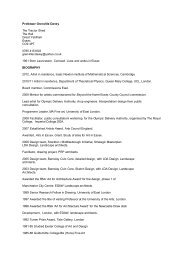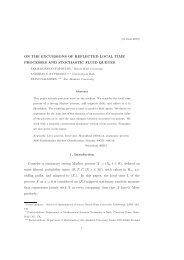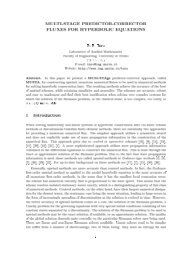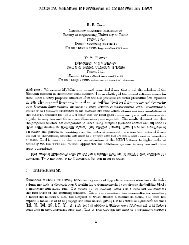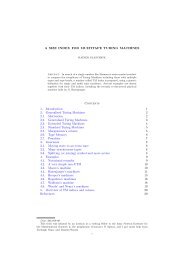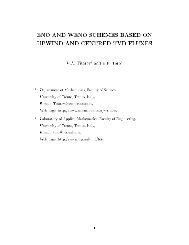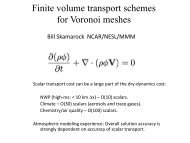Optimal Designs for the Prediction of Individual Effects in Random ...
Optimal Designs for the Prediction of Individual Effects in Random ...
Optimal Designs for the Prediction of Individual Effects in Random ...
You also want an ePaper? Increase the reach of your titles
YUMPU automatically turns print PDFs into web optimized ePapers that Google loves.
4 Maryna Prus and Ra<strong>in</strong>er Schwabe<br />
3 <strong>Optimal</strong> Design<br />
The mean squared error matrix <strong>of</strong> a prediction depends crucially on <strong>the</strong> choice <strong>of</strong><br />
<strong>the</strong> observational sett<strong>in</strong>gs x1,...,xm, which constitute a design and can be chosen<br />
by <strong>the</strong> experimenter to m<strong>in</strong>imize <strong>the</strong> mean squared error matrix <strong>in</strong> a certa<strong>in</strong> sense.<br />
Typically <strong>the</strong> optimal sett<strong>in</strong>gs will be not necessarily all dist<strong>in</strong>ct. Then a design<br />
� �<br />
x1 ,..., xk<br />
ξ =<br />
(7)<br />
w1 ,..., wk<br />
can be specified by its dist<strong>in</strong>ct sett<strong>in</strong>gs x1,...,xk, k ≤ m, say, and <strong>the</strong> correspond<strong>in</strong>g<br />
numbers <strong>of</strong> replications m1,...,mk or <strong>the</strong> correspond<strong>in</strong>g proportions w j = m j/m.<br />
For analytical purposes we make use <strong>of</strong> approximate designs <strong>in</strong> <strong>the</strong> sense <strong>of</strong><br />
Kiefer (see e. g. Kiefer, 1974), <strong>for</strong> which <strong>the</strong> <strong>in</strong>teger condition on mw j is dropped<br />
and <strong>the</strong> weights w j ≥ 0 may be any real numbers satisfy<strong>in</strong>g ∑ k j=1 m j = m. For <strong>the</strong>se<br />
approximated designs <strong>the</strong> standardized <strong>in</strong><strong>for</strong>mation matrix <strong>for</strong> <strong>the</strong> model without<br />
<strong>in</strong>dividual effects (β i ≡ β, i. e. D = 0) is def<strong>in</strong>ed as<br />
M(ξ ) = ∑ k j=1 w jf(x j)f(x j) ⊤ = 1 m F⊤ F. (8)<br />
Fur<strong>the</strong>r we <strong>in</strong>troduce <strong>the</strong> standardized covariance matrix <strong>of</strong> <strong>the</strong> random effects ∆ =<br />
mD <strong>for</strong> notational ease. With <strong>the</strong>se notations we may def<strong>in</strong>e <strong>the</strong> standardized mean<br />
squared error matrices as<br />
MSE β (ξ ) = (In − 1 n 1n1 ⊤ n ) ⊗ (M(ξ ) + ∆ −1 ) −1 + ( 1 n 1n1 ⊤ n ) ⊗ M(ξ ) −1<br />
<strong>for</strong> <strong>the</strong> prediction <strong>of</strong> <strong>the</strong> <strong>in</strong>dividual parameters and<br />
MSE b(ξ ) = (In − 1 n 1n1 ⊤ n ) ⊗ (M(ξ ) + ∆ −1 ) −1 + ( 1 n 1n1 ⊤ n ) ⊗ ∆ (10)<br />
<strong>for</strong> <strong>the</strong> prediction <strong>of</strong> <strong>the</strong> <strong>in</strong>dividual deviations. For any exact design ξ <strong>the</strong> matrices<br />
MSE β (ξ ) and MSE b(ξ ) co<strong>in</strong>cide with <strong>the</strong> mean squared error matrices (4) and (6),<br />
respectively, up to a multiplicative factor σ 2 /m.<br />
In this paper we focus on <strong>the</strong> <strong>in</strong>tegrated mean squared error (IMSE) criterion,<br />
which is def<strong>in</strong>ed, <strong>in</strong> general, as<br />
IMSE β = �<br />
X E(∑n i=1 ( ˆµi(x) − µi(x)) 2 )ν(dx) (11)<br />
<strong>for</strong> prediction <strong>of</strong> <strong>in</strong>dividual parameters, where ˆµi(x) = f(x) ⊤ ˆ β i and µi(x) = f(x) ⊤ β i<br />
denote <strong>the</strong> predicted and <strong>the</strong> true <strong>in</strong>dividual response, and <strong>the</strong> <strong>in</strong>tegration is with<br />
respect to a given weight distribution ν on <strong>the</strong> design region X , which is typically<br />
uni<strong>for</strong>m. The standardized IMSE-criterion Φ β = m<br />
σ 2 IMSE β can be represented as<br />
Φ β (ξ ) = (n − 1)tr((M(ξ ) + ∆ −1 ) −1 V) + tr(M(ξ ) −1 V), (12)<br />
(9)




